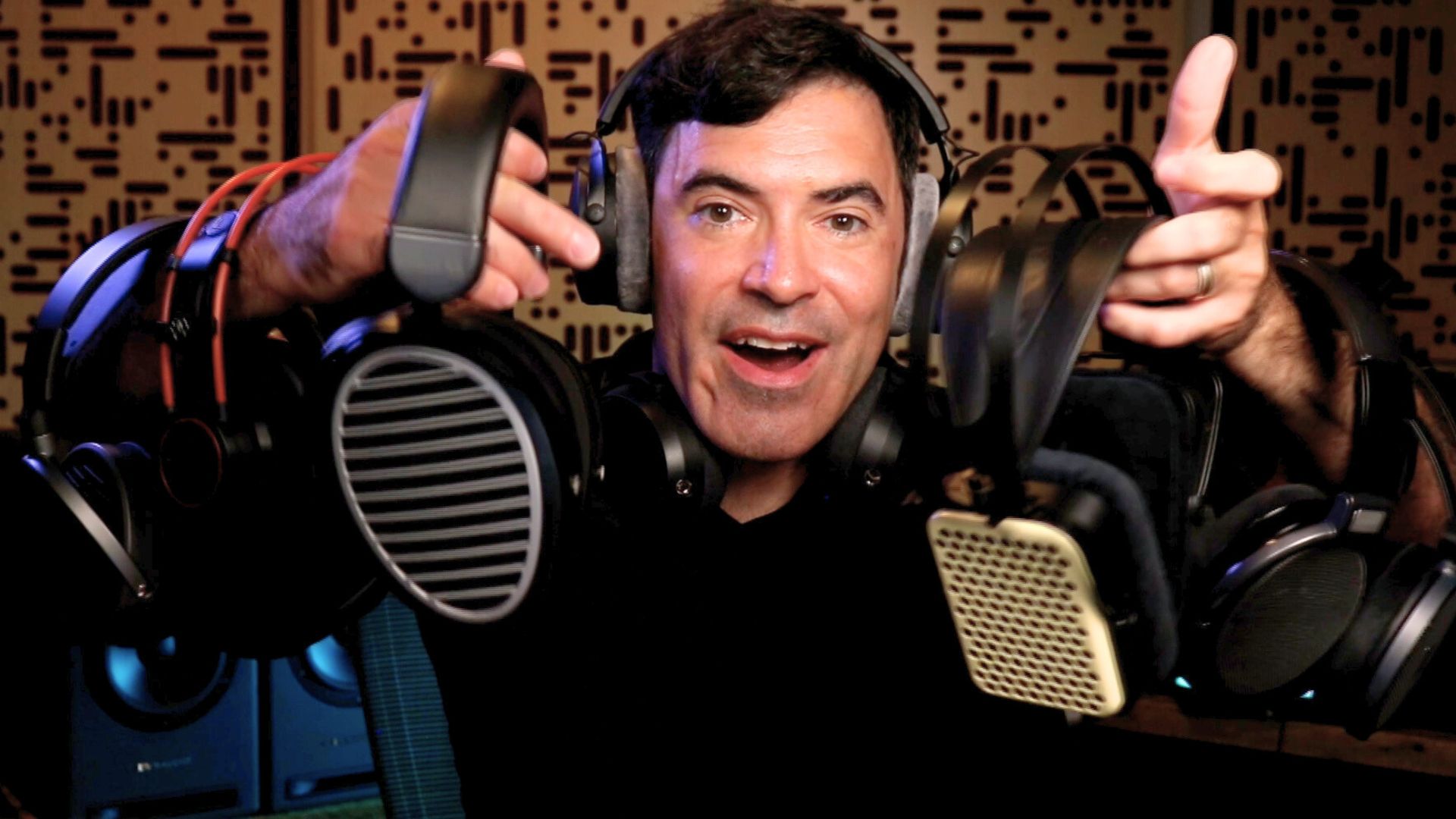Best Headphones for Mixing: $400 & Under [UPDATED 2025]
This article is also available as a video and podcast episode.

Introduction: Why Mix on Headphones?
I recently did a post on the best headphones for mixing and mastering, and it was one of our most popular of the year.
In it, I covered headphone models that ranged from $250 all the way up to $4,000 and above.
Today, I want to zero in headphones that are priced $400 and below—and include some new models that weren’t around for the original roundup.
I believe that the $300-$400 price range now holds some options that can give you truly professional results without much second guessing.
Once you start spending $300 or more, there are some headphones out there with surprisingly flat mid and high frequency response. And today, there are options that have shockingly good low end—often deeper, more accurate and more revealing than what you’ll find on speakers in most home studios.
Let’s face it: the harsh reality of working in makeshift studios is that room has even greater impact on your monitoring than the speakers themselves. Whether your budget is is $400 or $4,000, headphones can potentially perform even better than speaker setups at the same total budget—especially once you start taking the cost of treating the room into account.
Not long ago, most audio professionals would have discouraged you from mixing in headphones. But now, some of the very best in the world are doing it.
Major, platinum-selling mixers like Manny Marroquin, Ariel Borujow and Andrew Scheps, as well as high level mastering engineers like Glenn Schick, Brian Lucey and Gavin Lurssen have been working in headphones in recent years.
These days, I check every master I do in my trusty pair of Audeze MM-500 headphones. I know them so well, that I could master a whole record in them without even consulting my high-end studio monitors.
But I know that not everyone can justify headphones that cost upward of $1700. So, if I was going to spend less, what are the best options? That’s what we’ll explore today. I tried them ALL so you don’t have to!
Before we get into ranking my top picks, which includes brands like Audeze, Avantone, Sennheiser, Hifiman, Steven Slate, Blue, Sony, Shure, Ollo, and Audio-Technica, I want to give you a quick overview of the main types of headphones we’ll be looking at.
Planar or Dynamic Headphones?
We’re going to break up this post into two sections:
One on Planar Magnetic headphones, and one on Dynamic Driver headphones.
My personal preference these days is for planar magnetic headphones, like my beloved Audeze, and the great Focal Clear series.
The pros of planar designs is that they have much better transient response and greater detail without undue brightness, as well as often getting more low end out of an open back design when compared with dynamic driver headphones.
Put simply, planar headphones can get you better sound quality in practically every point that matters.
The problem?
Planar headphones cost more, and they weigh more.
Until VERY recently, it was hard to find planar magnetic headphones—especially ones worth using—for under $1,000. Some of the best models could easily run $1,500-$5,000.
But all of that has changed in recent years. There are now very good quality planar magnetic designs available for $400 and under!
So, why would anyone want Dynamic headphones?
Well, for one thing, classic dynamic driver headphones are MUCH lighter, and therefore, they’re often much more comfortable for extended wearing.
Dynamics are also much more affordable to produce than planar headphones, so makers of dynamic models can often stack a lot more features into their offerings.
Notable here are the Slate VSX headphones which emulate recording studios and other headphones, as well as the Sennheiser 490 Pro, which come with Dear Reality’s room modeling and headphone correction software, as well as interchangeable ear pads for further variation in tone.
Open Back VS. Closed Back
The majority of headphones we’ll be looking at today will be open back models, as they will generally have the flattest frequency response and fewer resonances, making for mixes that translate better.
The potential tradeoff is that open back designs can have less deep bass extension than closed backs, but planar magnetic designs tend to perform better in this area, and the latest crop of dynamic driver open back headphones are far better in this regard than in the past.
A couple of notable exceptions here are the Slate VSX—which make up for the inherent frequency response issues of closed back headphones with some very clever software—as well as the now-discontinued Blue headphones, which use a semi-closed/semi-open design.
Skip the Introduction, Get Me Right to the Headphones!
OK, fine, you’re already sold on the idea of mixing on headphones. What are the best ones?
Let’s go through all the most popular models from most to least expensive, with my recommendations and notes on each.
Audeze MM-100 — Winner: Best Overall ($399)
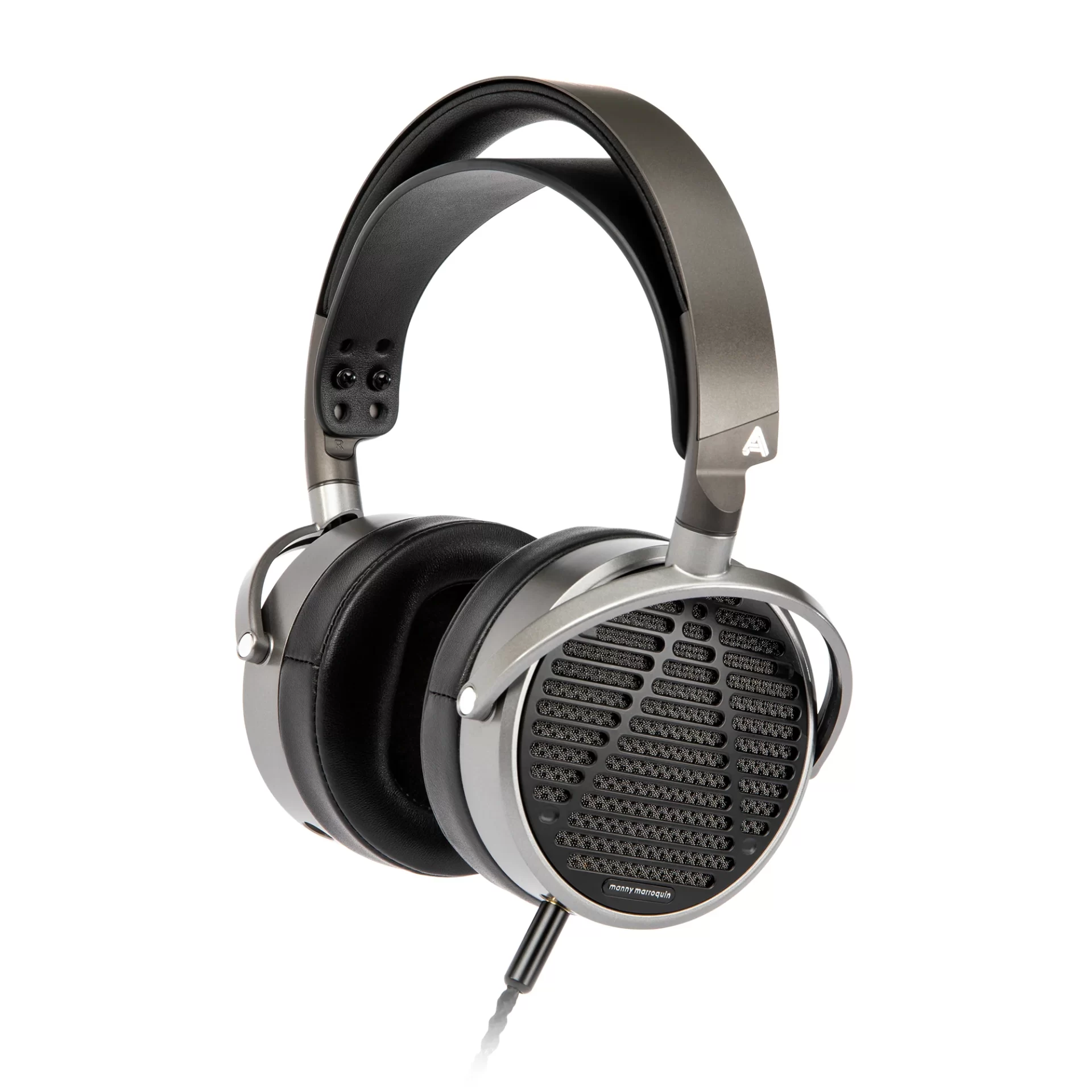
Audeze MM-100
Buy it new on Sweetwater, B&H, Thomann, or Amazon. Look for deals on Reverb.
I still remember the first time I heard a pair of Audeze headphones. When I put on their then-flagship LCD-4 headphones for the first time, my jaw dropped from its hinge:
“No headphones have any business sounding this good” I thought to myself.
The only catch? ..Those high end LCD-4 headphones cost about $4,000!
The MM-500, which are currently priced around $1600, were designed in collaboration with multi-platinum mixer Manny Marroquin, and for a fraction of the price, they perform about 90-95% as well as their top of the line models that cost 3 to 4 times more.
The even less expensive MM-100 cost 4X less than the MM-500 and similarly, perform about 90-95% as well as their bigger brother.
The difference in frequency response is pretty minimal, with the MM-100 being perhaps the tiniest bit lighter in the low frequencies, possibly due in part to the ever-so-slightly smaller earcups. Their profile felt just a tiny touch brighter in the upper mids, with the smallest, almost imperceptible amount of extra “bite” there.
Only marginally more noticeable was the difference in transient response, which less experienced listeners may not pick up on at all. The higher end models have ever so slightly faster response in this area, but the more affordable MM-100 still beat out any dynamics in this category, and are as good or better than their planar competition in this price range.
The MM-100 are packaged beautifully for a headphone in this price range, and the build quality, feel and presentation were excellent—once again, as good and usually better than other comparably priced planar models.
Like the MM-500, the MM-100’s can thank their planar magnetic design, open back and large ear cups for giving them a truly speaker-like impression in sound—complete with shockingly useful and trustworthy low end for headphones, down into the sub region.
These headphones sound “open”, pretty and un-fatiguing, but without sounding hyped or overly attractive. They are extremely useful, honest, and fun to listen to at the same time.
My only criticism of the MM-100 is that, like all planar headphones, they are a little large and a little heavy compared to some of the other headphones on the list.
That said, they are still lightweight and comfortable enough for my purposes, and I feel the less expensive MM-100 actually beat out the higher end MM-500 on style due to the more streamlined headband design.
Shockingly for a pair of planar headphones at this price, they are made in the USA, which is a nice touch and a small selling point for me. There is obviously some pride in craftsmanship, details, and delivery with these headphones, which is always a nice touch.
Avantone Planar the II — Winner (Tied): Best Overall ($399)
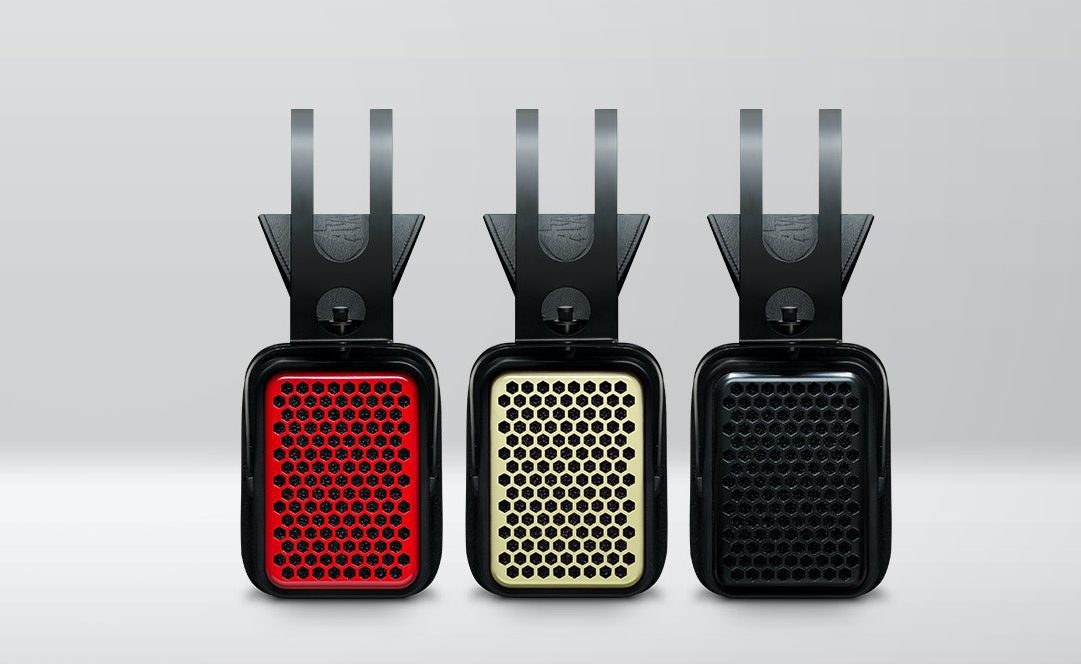
Avantone “Planar the II”
Buy it new on Sweetwater, B&H, Thomann, or Amazon. Look for deals on Reverb.
This unique and unusual rectangular design was my wife’s favorite looking of the bunch, so if you are looking to score style points, they are potentially a winner there.
Fortunately, they are also a winner when it comes sound quality! These were just about neck-and-neck with the Audeze in sound for my personal tastes, and depending on your tastes, you may even prefer them.
Compared to the MM-100, Avantone’s “Planar the II” had a slightly more solid and beefy sound, with just the tiniest bit more “oomph” and thickness in the lows to my ear.
Perhaps due to the ever-so-slightly shallower ear cups, they sounded ever-so-slightly “drier” and more direct, with a slightly more “headphone-like” rather than “speaker-like” presentation.
Mixes in the Avantones sounded slightly beefier, more solid and closer, while in the Audeze they were slightly more spacious and open and surrounding.
The differences here however, were very slight. If you picked your favorites of the two by throwing darts at a board, I have no question you could make great mixes with either.
Because your mixes will sound like the inverse of your monitors to some degree, if you find yourself mixing too dry and bass heavy, the Avantones may help reel you in slightly, while if you find yourself mixing too wet and bass-light, the Audeze may help guide you in the right direction more easily.
The build quality on these was fabulous, and like the Audeze, they were quite comfortable over long periods for a relatively substantial and weighty set of headphones.
Hifiman Edition XS — Winner: Lightest Weight Planar Design ($499, marked down to $269)
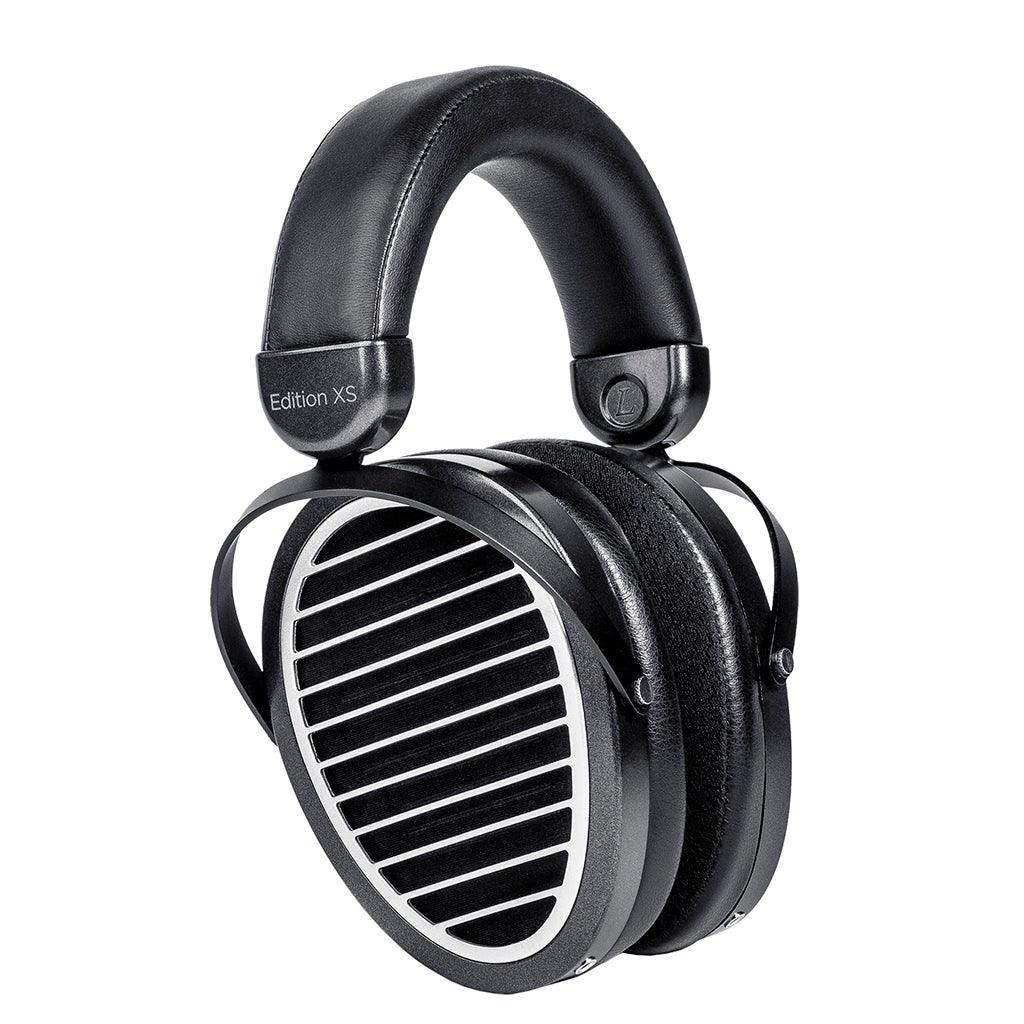
Hifiman Edition XS
Buy it new on Sweetwater, B&H, Thomann, or Amazon. Look for deals on Reverb.
Before I started getting these comments, I have to admit that I had never even heard of Hifiman headphones.
Since I’m focused on the pro audio market and models that are normally found at pro audio-focused retailers, they just weren’t on my radar until now.
In case you’re not familiar with them, they are a newer brand that specializes in affordable planar magnetic designs, and they appear to be very successful with sales on Amazon, often offering substantial discounts on older models as they continuously appear to revamp and update their line.
The Edition XS, which I ordered on sale for $269, marked down from $499, replaced an earlier “Edition X” model, and are presumably being replaced with yet another new version.
Comparably priced models include the Andana for $399, which are a planar design similar to the Edition series, that supposedly have slightly less low end, but an ever so slightly brighter feel.
Where these headphones win over the Audeze and the Avantone is that they are considerably lighter in weight, closer to the weight of an average dynamic driver headphone rather than an average planar magnetic headphone.
If you are looking for the excellent transient response that planar designs have to offer without the added heft, then these are a potentially excellent option. (Especially if you can snag up a clearance price deal on an older model.)
But their greatest benefit is also possibly tied up in what may be their greatest potential weakness:
Compared to the prior two brands mentioned, the build quality here just doesn’t feel nearly as robust. The parts involved feel not only lighter weight but “cheaper”, less sturdy, less refined, and they seem less durable.
Looking through Amazon reviews, it appears that the biggest compliments are about sound quality relative to price, while the more frequent complaints seem to be around build quality and quality control.
Fortunately, the positive reviews seem to far outweigh the negative reviews, but it’s hard to say for certain based on the trend of decreasingly reliability and increased gamification of Amazon reviews in recent years, especially among high-volume products.
As far as sound quality, I felt these were a close runner up to the Audeze and Avantone. A few things to note there:
First, these headphones are considerably lower output than the Audeze and Avantone, and I had to turn up my headphone amp another 20-25% of the way to level match them for comparison testing.
Second, their light weight made them sound even less isolated from the surrounding environment than the other planar models on this list.
And third, perhaps due to the lighter magnets, they didn’t seem to have the same transient speed and detail as the prior models mentioned.
This last item is one of the most important things I look for in high quality headphones, as frequency response can be corrected with software or accommodated through experience, but transient response cannot.
With that said, their transient response is better than any of the dynamic headphones we’ll look at later on, so they could still be a very worthwhile buy, especially when on sale.
Also in their favor, according to certain headphone review sites, these headphones actually outperform many other headphones based on frequency analysis data—including some of the headphones that I personally prefer over them.
I think this is what is partly behind their success: These are indeed low cost planar magnetic headphones that spec out very well in terms of frequency response, given a standard method for measuring headphone frequency response.
However, at this point it’s worth noting that the “standard method” for evaluating headphone frequency response is quite controversial. (If you can even say that there is a standard method, which is arguable. Let me know if you want to see a whole post on this topic!)
The bottom line is that frequency response data for headphones can be incredibly misleading, and even the best data available is nothing like the fairly objective frequency data we can collect for speakers or microphones.
This is why I don’t rely on frequency response data it in these headphone reviews, and only compare the relative sound of headphones to one another, rather than trying to compare them to an objective baseline.
…Because the reality is, when it comes to testing the frequency response of headphones… there is no objective baseline!
Completely raw frequency data from headphones is so wildly misleading, that the standard industry practice is to take the crazy-looking frequency response curves that come out of headphones and compare them—not against a flat frequency response—but against some kind of also wildly-skewed “headphone perception weighting curve” *. (Such “the Harman Curve”.)
[*=Note: This is a term I just made, but it works, so I’m going to use from now on it! :-]
Unfortunately, any headphone perception curve is based on the assumed perceptions of some presumed average listener… who might not actually be very “average” at all!
These kinds of comparisons say nothing about how you will perceive the flatness of the headphone’s frequency response based on the unique shape and physiology of your outer and inner ear.
That’s right: We all hear the same exact headphones differently—even if we put personal preferences aside and try to determine only the perceived “flatness” of the headphones.
As an analogy, just because the “average person” fits into a size medium t-shirt, doesn’t mean that a size medium t-shirt will be your best fit.
(…Even if we could agree on an objective standard for what “fit” means… which is another issue in and of itself!)
The problem of measuring headphones is, unfortunately, beset on all sides with serious methodological issues.
Even in gathering the initial raw data, the rigs that are used that can skew the results in ways that are not a problem for speakers and microphones.
Then, when creating a perception curve to compare the raw frequency data against, you have to make a large number of assumptions, shortcuts and tradeoffs. (The popular Harman Curve is particularly beset with these issues.)
And, to top it off, once you make a perception curve and compare the raw data against it, the resulting frequency response curve would only be accurate for a mythical “average” listener… who is likely in the minority of listeners…. if he even exists at all!
With all that said, if you are looking for a pair of planar magnetic headphones that are remarkably lightweight, spec out very well against the Harman curve in frequency tests, and can sometimes be found on sale at a steep discount, these are a very solid option!
When priced the same as pro audio brands like the Audeze and Avantone models, I find they fell slightly short in terms of build quality, robustness, transient response and output level.
But, when found at a discount, like I found for these Edition XS at just $269, they are remarkably good value, as long as they are robust enough to handle the way you use headphones day after day.
As far as frequency response, that’s a very personal matter. I preferred the sound of the Audeze and Avantone, perhaps because they are more familiar curves to me, and they helped me hear additional midrange detail without excessive top end brightness.
Relative to those models, the Edition XS had more high frequency, and a pretty different upper mid profile.
Remember that your mixes will generally sound a bit like the inverse of your headphones.
If you are mixing with excessive top end in the 8k or 10k+ region, the Edition XS may help you reel it in as they are a bit more active in that area.
And if your mixes are too bright in the 5k-ish region, they may encourage you to push that area a little bit more relative to the MM-100. Meanwhile, they may encourage you to push slightly more 3k.
Also remember that frequency response can be corrected for more easily with software like Sonarwarks if desired than other aspects of quality, such as build quality and transient response.
Sennheiser HD 490 Pro — Winner: Best Overall Dynamic Headphones (Starting at $399)
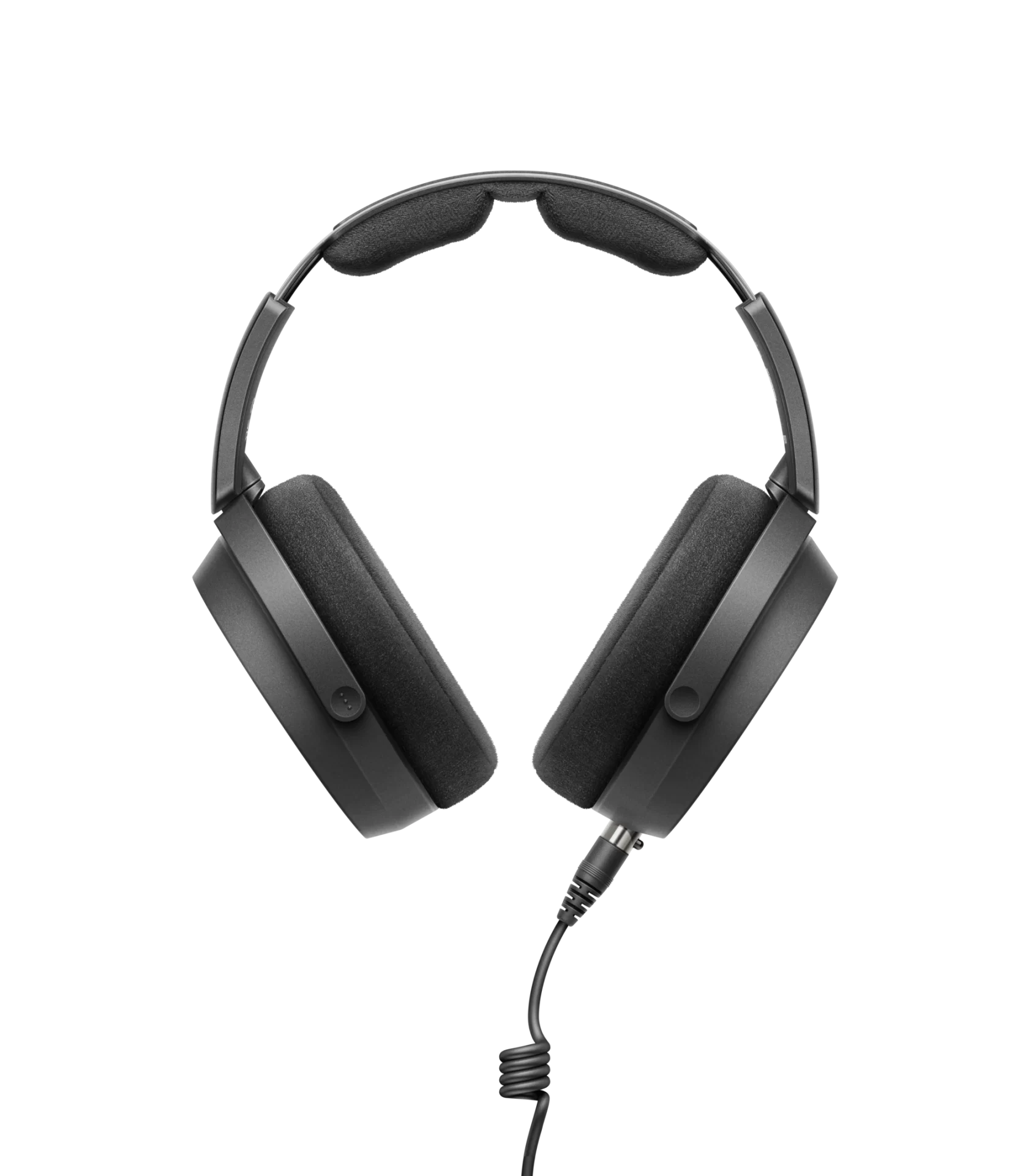
Sennheiser HD 490 Pro
Buy it new on Sweetwater, B&H, Thomann, or Amazon. Look for deals on Reverb.
These were a long-awaited upgrade to the prior Sennheiser HD 600, 650 and 6XX models, which were recording studio favorites for decades, setting the standard for open back dynamic headphones for a long time to come.
So, how do they compare?
I’m happy to say that the HD 490 Pro are a marked improvement on the earlier HD 600 series models in basically every way!
One of the biggest issues with all the 600-series models is that—despite their truly excellent mid and high frequency response—they were relatively bass light, with very little useful information below 100Hz.
While that might have made sense in large recording studios with great monitors and room treatment that just needed a secondary headphone check, it’s almost exactly the opposite of what the average home or project studio owner needed. And so, I rarely recommended them.
Fortunately, I can recommend the 490 Pro. They keep the high quality mid and high frequency response of the older Sennheisers, and then add on substantially more ample low frequency reproduction.
If they still don’t have enough low end for you, you can ramp it up even more by switching to the thicker interchangeable “Producer” earpads which give a little additional lift below 100Hz.
Because these are a dynamic model, they are much lighter weight than any of the Planar magnetic designs we’ve looked at so far. And, they are an improvement in fit and feel over the prior 600-series, with less cranial “pinch” and even greater comfort.
Also, because they are dynamics, they can offer more features at the same price point. In addition to the interchangeable ear pads, these headphones come with custom Dear Reality software that allows the headphones to emulate the sound of a perfectly tuned mixing studio, to help you make balance and panning decisions that should translate to an even wider range of systems. Or you can further “correct” the frequency response for even flatter headphone playback.
If you are looking for an all around great pair of dynamic headphones, it’s hard to do much better than the HD 490 Pro.
For users who want even more low end, or even better transient response, the planar models may outperform them, though at the cost of additional weight.
Slate VSX Headphones — Winner: Most Innovative ($299)
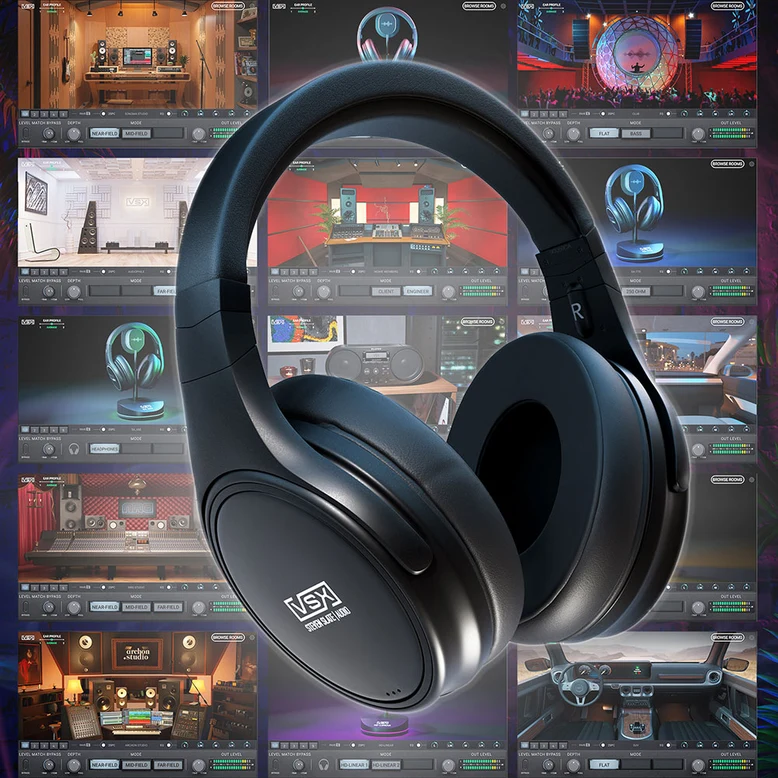
Slate VSX
Buy it new on Sweetwater, B&H, Thomann, or Amazon. Look for deals on Reverb.
By themselves, they are a fairly good sounding pair of closed back headphones, with surprisingly good low frequency extension for their price, though perhaps a bit dark sounding…
…But you’re not supposed to use them by themselves!
What makes these headphones shine is the included software, which can used as a plugin in your DAW or a systemwide plugin.
The basic flat “linear” version of these headphones makes them perform incredibly well for $300 headphones by themselves. But the most unique feature is the ability to audition your mixes in a variety of environments from high-end studios to cars to other models of headphones.
These sound and work way better than they should for $300, and there’s no question they beat out basically any headphones that cost less.
My only critique is that the amount of choice you have in the software is potentially overwhelming. It’s probably better to deeply learn 1 to 3 playback systems than the potentially dozen or more that you can have access to in this software.
I’m also not sure I’d love having a pair of headphones that was tethered to software, but it doesn’t seem to bother the countless lovers of this solution.
These are a very remarkable and unique option. They don’t quite have the transient accuracy of the highest end models available, but their frequency response can be fantastic with the appropriate models applied.
If you want a light weight dynamic model with potentially more low frequency response than the Sennheisers, and more acoustic isolation thanks to their closed back design, this is a good pair to look at.
Sony MDR-MV1 — Winner: Lightest Weight Dynamics ($400)
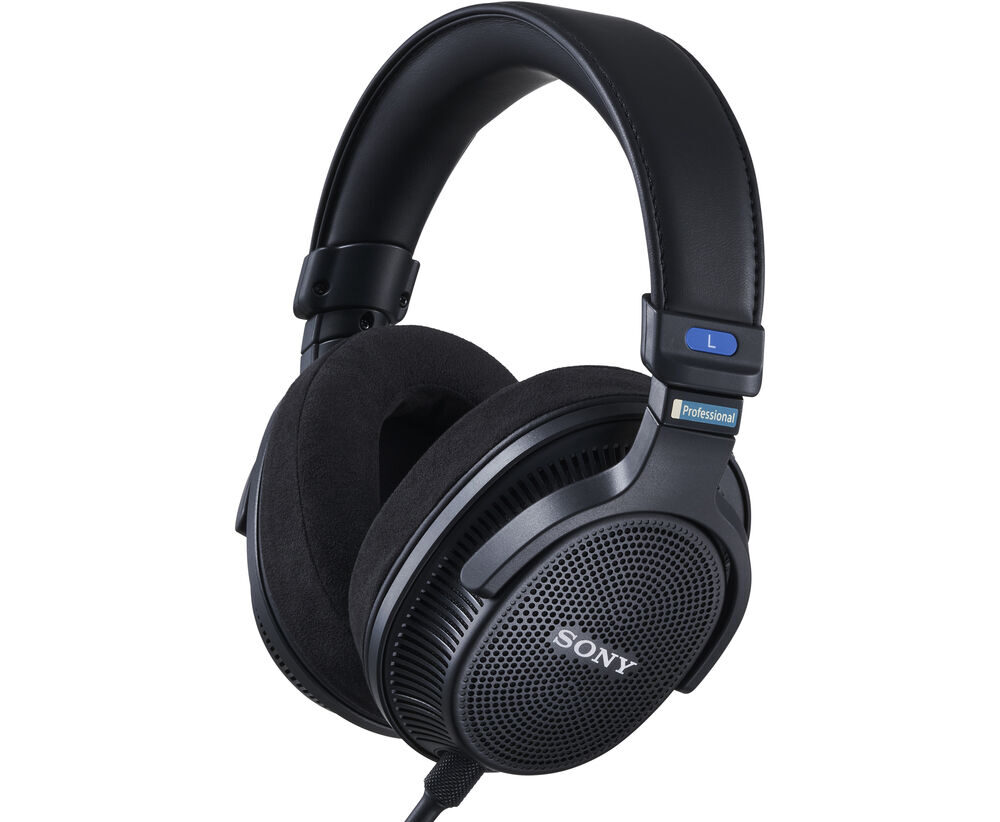
Sony MDR MV1
Buy it new on Sweetwater, B&H, Thomann, or Amazon. Look for deals on Reverb.
Although I’m not a huge fan of the classic MDR-7506 headphones for mixing because they are a bit too bright and hyped for my personal needs, they are great tracking headphones in my book. And there is no doubt that they are some of the most popular pro headphones in history, with a countless number of die-hard fans.
(Plus: Andrew Scheps mixes on them, so who am I to argue? I have a personal soft spot for the smaller and less hyped 7502 headphones, as well as consumer Sony walkman headphones, both of which I used as a secondary mixing reference for years.)
The new MDR-MV1 have some of the bold and exciting sound of the MDR-7506 headphones, while being more neutral and more useful for mixing and critical listening.
They struck a nice balance with a sound that will be immediately familiar and satisfying to those who have loved Sony headphones in the past, without going overboard with too much of a sonic signature.
The low end is great here, as is the high frequency detail. They are perhaps slightly soft in the low and center mids, which helps give them a slightly more scooped and bombastic sound than the Neumanns that won for my personal top pick in this category.
For those who want a mixing headphone that is flat enough to make great critical listening decisions on, and exciting enough to make the process of mixing fun and inspiring, these could be a great way to go.
The only weakness of the build is also one of this model’s greatest strengths: these headphones are remarkably light. Like, crazy light. They are easily the lightest of the bunch that I tried.
At first touch, the lightness made them feel flimsy to me. But the more I listened, the more I came to appreciate it. You barely know they are there! You could wear these all day and never feel it.
Be warned: You might find yourself accidentally leaving the studio and going to dinner with them still on!
Another advantage is that a select number of studios are certified by Sony to help you create a personalized HRTF profile for these headphones, making them even flatter and custom tailoring-them to the way you hear.
Austrian Audio Hi-X60 and Hi-X65 Winner: Best Small Profile Headphones ($429)
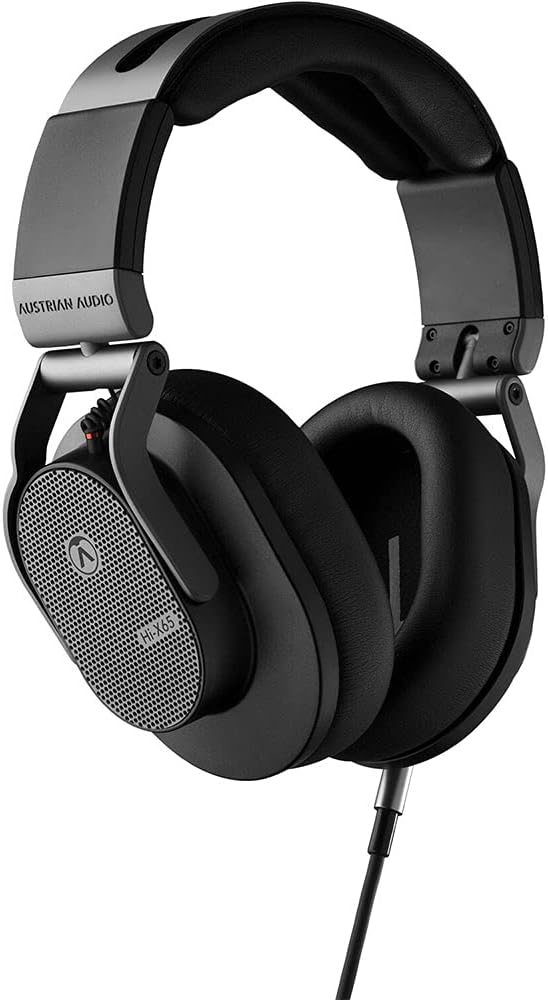
Austrian Audio Hi-X65
Buy it new on Sweetwater, B&H, Thomann, or Amazon. Look for deals on Reverb.
These are easily the most compact high performance headphones on this list. The only others that come close are the Sony MDR MV1 and the Slate VSX, and both are considerably larger.
For my tastes, these have the best visual appeal for those who need to be on camera for streaming, podcasting, recording sessions, video interviews and the like—especially if you are a smaller person or have a smaller head.
No joke, this is something that a lot of people just don’t think about until they buy their headphones and look at themselves in the mirror. And depending on what you’re doing, it can matter!
Additionally, both these headphones sound good. The Hi-X60 are among the better sounding closed back headphones that are out there, nipping at the heels of the more expensive ADAM and Neumann closed back models. While they are not flat (no headphones are, closed back models in particular) they are pleasant and useful and a solid contender for the style at any size or price.
The open back Hi X65 are clean and fairly flat with revealing midrange. But they do have a distinctive sound. There’s a certain “thwack” or meat to center midrange that I don’t hear in other models. It seems like a bit of a lift up around 300-400Hz and 700Hz-800Hz and maybe a bit of a dip a bit further up.
They were certainly unique and not voiced like any other brand of headphones I’ve encountered. If you’re looking to be led in the direction of getting cleaner more open sounding mixes, these could help you go there, in a way that sweeter and more low mid “scooped” headphones may not.
Honorable Mentions
Blue Mix-Fi — Runner Up: Most Useful / Best Low End $300 and under
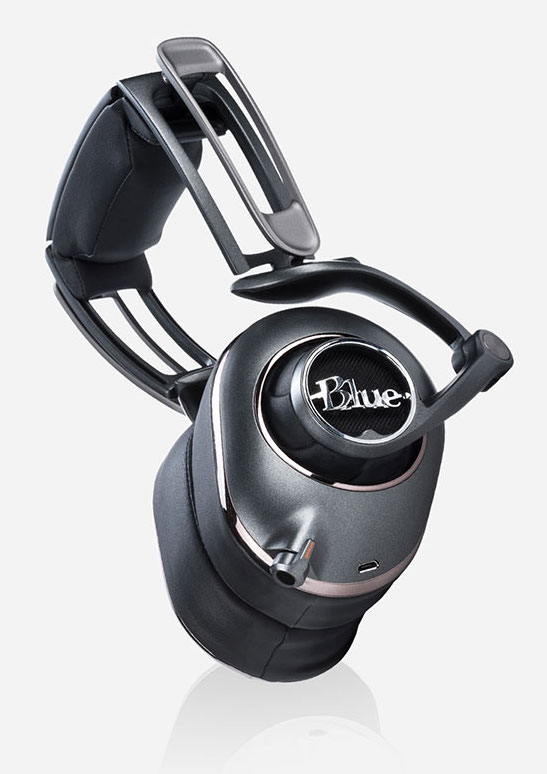
Blue Mix Fi
Buy it new on Sweetwater, B&H, Thomann, or Amazon. Look for deals on Reverb.
I still love them, but they are now discontinued. You can find pairs of these and the almost identical Lola headphones on the market for very low prices, but note that the covering on their earpads is prone to flaking off over time, and cannot be easily replaced.
This aesthetic issue aside, they are great headphones for mixing. Here’s what I wrote about them in our last headphone roundups:
When I first got a demo version of the Blue Mix-Fi headphones to try out, I let them sit on the shelf, unopened, for months. To be honest, they looked a little weird to me. I couldn’t tell if they were open back or closed, and I assumed, based purely on aesthetics, that they would be all hype and no substance. Boy was I wrong.
The Blue Mix-Fi headphones absolutely blew me away from the very first listen. I found this especially surprising because they are nowhere near the most expensive model on this list! In fact, they are among the less expensive entries here. But from moment one, I experienced something that I am not accustomed to on anything but great high end speakers: I could not only hear the bass, but I could feel it.
And I don’t mean that I could “feel” the bass in a “totally hyped up to make you bang your head” kind of way. Not at all. The bass here is remarkably free of resonances for a pair of headphones, and there is actually some truly useful information going on in the low frequencies in these.
I’m not just talking about the upper bass here, either. I’m talking about the very low lows. I was surprised to find that I have come to trust the low end response of these headphones so much that I am comfortable making critical listening decisions about the bottom end in them. This is true even for the subs, down as low as 55Hz-65Hz or thereabouts. This is extremely unusual for any kind of headphone—especially without resonance issues. Color me impressed.
On several occasions, I was able to do mastering revisions using nothing but these headphones—including choices about the low frequencies—and then take them off, only to find that my choices would have been no different on my main speakers. This astonished me more than anything else.
Are the lows perfectly flat? No, the lows in headphones never will be, even if you spend 5 times as much as you might on these. I’d estimate that the low end here is slightly highlighted, if anything. But this feels like a useful feature more than “hype” to me, especially because the lows here are remarkably clean and surprisingly free from resonances. These are indeed some of the most useful lows I’ve ever encountered in a pair of headphones, even when compared to some more commonly encountered models that cost more.
Bottom line: If you don’t want to spend a lot, and your primary need for headphones it to double-check low end in a compromised room, then these are probably the headphones I’d recommend first.
There’s something else that is remarkable about these headphones too: They are technically not an open-back model. Rather, they are what I would call a “semi-open” design. They rely on a dampening system to deliver clean, resonance-free lows rather than an open back. This means that you get some of the extreme isolation from outside distractions that you’d expect from closed back headphones, so you can even record while wearing them without worrying about silly amounts of bleed like you usually would with normal open-back designs.
As mentioned, the Mix-Fi headphones are remarkably inexpensive for their performance. At only $300 they’re among the least expensive entry on the list.
Okay, with all those raves, is there anything I don’t like about them? Unfortunately, yes. I’ll be the first to admit that despite all of these great points that made me fall in love with the Mix-Fi model, they look… well… kinda…. um…. “silly” is the nice word for it.
There, I said it. When I put these things on, I look like an air traffic controller. And as much I respect the company for their novel aesthetics, some of the BLUE designs are just a little far-out for my more “classic-y” tastes.
These are also some of the heavier headphones on this list. Fortunately, thanks to some excellent ergonomic design, they don’t feel uncomfortable at all, even over very long periods. If anything, they feel pleasantly “substantial”, and I found that I can wear these for hours without issue. I would just keep the headbanging to a minimum.
Of course, all these are my personal aesthetic judgements, and yours may be different. They’re not deal-breakers, even for me. And if you have more futuristic tastes (or a slightly larger head) than I, you may find that the look of them suits you just fine. But as far as my tastes go, I only wear these in the studio. I just wouldn’t feel right rocking them in the street or on the subway. But maybe I’m a square.
Finally, for some tastes, the top end on these could seem a little bit dark—particularly with the amp turned off. But for me, this is a feature rather than a bug, especially when it comes to long stretches of critical listening.
If you like the idea of a dark and smooth top with full low end, which reveals lower bass problems while encouraging you to push the top end a bit more, then these could be great for you. But each person’s tastes are different, and if you prefer a little bit more clarity, detail, and sparkle on top, you might prefer other headphones on this list.
Blue has also more recently developed a planar magnetic version of this design, called the Ella, that sounds superb. It’s also slightly smaller and lighter weight.
The Ella has even more high frequency detail than the Mix-Fi while still sounding exceptionally smooth. The bass is extremely even on the Ellas, though perhaps slightly less pronounced than in the Mix-Fi. The Ella model may be slightly more “expensive”, “smooth” and “even” sounding—with the tradeoff being that it lacks just a little bit of the beefy, subby fullness of the Mix-Fi, which I found to come so much in handy as a secondary low end reference.
Although the Ellas cost more than twice as much, but if I was listening only for fun, I’d have to admit they sound “better” in some ways. But even with this in mind, I still find the Mix-Fis exceptionally useful, their value is hard to match, their usefulness in double-checking deep lows in compromised environments is superb, and I won’t be giving mine up anytime soon.
There are a few other great attributes to both models, such as the cabling, and the fact that they give you an optional 3-ring 1/8″ connector complete with a microphone and volume control for use with your smartphone.
Theoretically, the built-in amp is nice to have for use with smartphones and the like, but I found that he Mix-Fi could get more than loud enough without it, and I actually preferred the slightly mellower and low-end focused tone of the headphones without the built-in amp engaged.
[Note: There’s also a less expensive version of the Mix-Fi, called the Lola, but these appear to be being phased out, as they are no longer referenced on Blue’s website. The Lola model goes for at least $50 less where you can still find it. They are practically the same as the Mix-Fi, aside from the omission of the onboard amp found in the Mix-Fi model—which I don’t use anyway. If you want to save a few bucks, they could be a good buy. There is also a model call the Mo-Fi that is basically identical to the Mix-Fi]
Pros: Great value, amazing low end for headphones. Offers the resonance-free performance of open-back coupled with acoustic isolation of closed back.
Cons: Unusual “love it or hate it” aesthetic design, Somewhat larger and heavier than other options. Could sound a little “dark” in the top end for some tastes, particularly without the built-in amp engaged.
Shure SRH1840 — Runner Up: Best All Around Dynamics ($500)
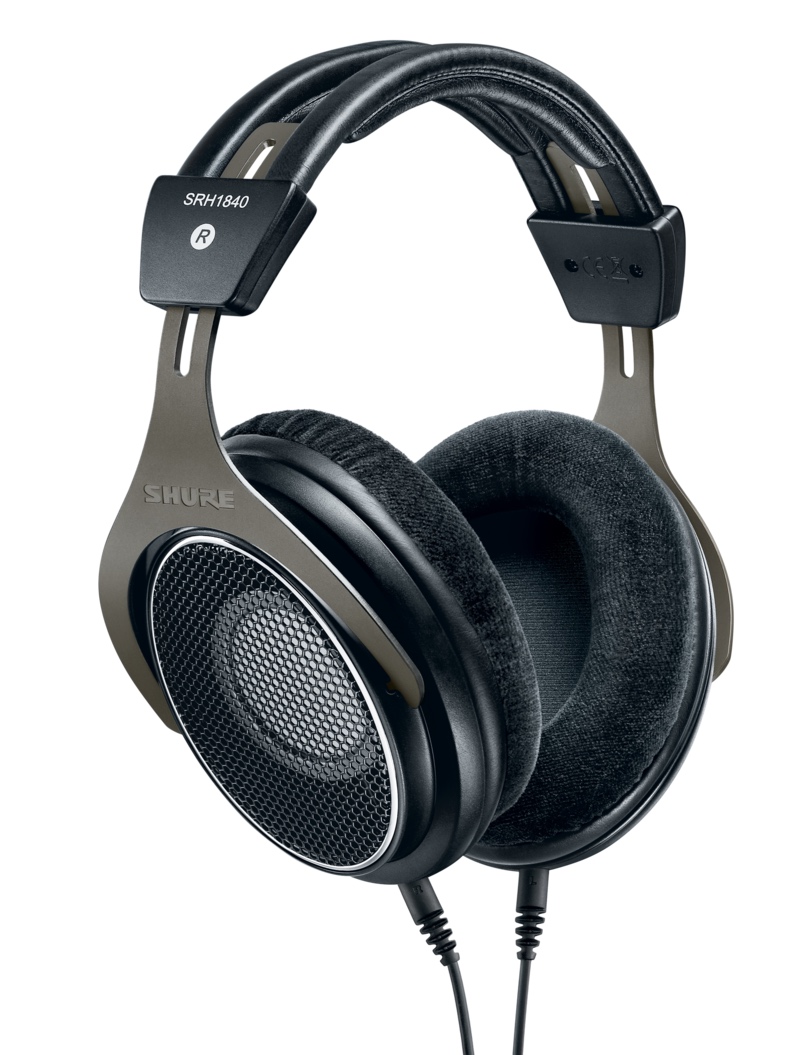
Shure SRH 1840
Buy it new on Sweetwater, B&H, Thomann, or Amazon. Look for deals on Reverb.
In my estimation, these are like an all-around “better” version of the Sennheiser HD650s, and offer a lot of the best qualities of other models mentioned earlier in a single package.
These are truly one of the best balanced options in the headphone world, and I was surprised by how much I liked them.
In my opinion, these were the best all-around open back headphones until the Sennheiser HD 490 Pros came out. They’re still at least as good, and some may like them even better. But they do cost a bit more, so they have to get knocked down a peg for that.
After hearing the SRH 1840, I couldn’t figure out why people don’t talk about these at least as much as the Sennheiser HD650s. Is it just the slightly higher price tag? They do come with a hard case to help offset the pricing difference, which is a nice touch.
Pros: Excellent sound with useful low end, and neutral but pleasing midrange and highs. Fantastic balance of features for a extremely well-rounded offering. Comes with an attractive complement of accessories, including a hard case for travel.
Cons: Not as affordable as some similar options. The Sennheister HD650 or Audio-Technica ATH-R70X (discussed below) may have a leg up on value for the budget-conscious. They feel luxorious, satisfying and fun compared to other offerings at a similar price point, though not as much so as the Focal models or other offerings from more hi-fi oriented brands.
Audio-Technica ATH-R70x — Runner Up: Lightest Weight Dynamics $350
Another set of headphones worthy of mention is the Audio-Technica ATH-R70x, which were probably the lightest weight dynamics available until the Sony MDR V1 came out.
They are extremely comfortable and easy to wear, and are very good sounding headphones for the price.
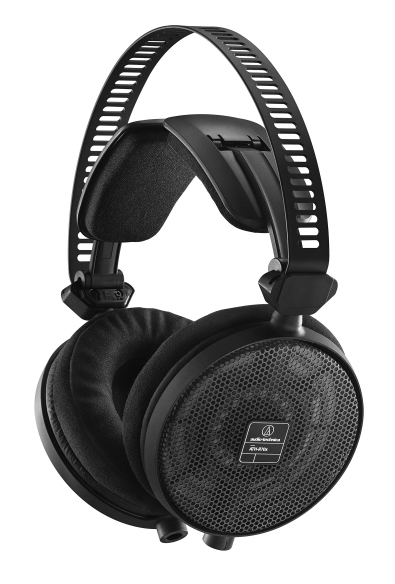
Audio Technica R70X
Buy it new on Sweetwater, B&H, Thomann, or Amazon. Look for deals on Reverb.
At a price lower than either Sennheiser and Shure, they are a great option for high-quality dynamics headpones.
They felt just slightly darker than the Shures or the Sennheisers, and a little less “open” and pretty.
This is not necessarily a bad thing though. Their slight emphasis on the midrange can encourage you to bring some more hyper and dazzle to your actual mixes.
Runner Up: Most Luxurious / Most Fun
Ollo HPS S4 $360~
If you want some headphones that are exceptionally comfortable, light, stylish and fun, the OLLO HPS S4 model might be a good bet for you.
These headphones are $350 in USD, but they are appointed like higher-end hi-fi headphones in some ways. They have a classic look with a beautiful walnut wood finish, reminiscent of the Grado line, and they are very lightweight and comfortable.
Though the company boasts about the flatness of their headphones, I found that they were a little bit more hyped than flat in use, though in a pleasing and detailed way. They felt a little bit amped up in both the lows and highs to my ears, which on the positive side, gives them the sense of offering plenty of articulation and excitement.

The OLLO S4
Buy it new on Sweetwater, B&H, Thomann, or Amazon. Look for deals on Reverb.
So if you’re looking for a little style out of your headphones and a little excitement out of their sound without going overboard, then these are a good bet for that.
They don’t quite compete with the neutrality of the Sennheisers or Shures, but that’s not what I like about them.
OLLO also offers a closed-back version that I have used on the SonicScoop podcast because of how light and comfortable and good-looking they are. The closed back S4R model make for a superb tracking headphone for a studio that wants a little more style and excitement than the average fare.
Another plus is that the design here is so simple that they are extremely serviceable headphones if you run into issues of wear over time.
My one complaint with these is the headband design. They can resonate a little bit if you bump them, and I found the black finish on mine started to peel slightly over months of use. The company reports that they are aware of this complaint and working on fix. Finally, they are not the most collapsible models you’ll find, making them a far better studio model than a travel pair.
Pros: Great style at a good price, excellent comfort, easy to wear for long periods, pleasant amount of sonic hype without going overboard.
Cons: Slight “smile” curve in the EQ is less than ideal for critical listening. Not easily collapsible for travel. Headband can ring audibly if struck. Finish on headband can peel slightly over time.
Final Thoughts
The best thing you can do is try some of these headphones out for yourself. I hope that at the very least, this list helps you narrow down your choices, and and provides some context for making your choices.
Justin Colletti is a mastering engineer, author and educator. He edits SonicScoop and hosts the SonicScoop Podcast. He is the creator of the full-length courses Mixing Breakthroughs and Mastering Demystified.
Please note: When you buy products through links on this page, we may earn an affiliate commission.







